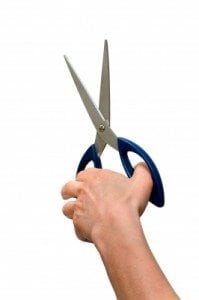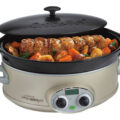The economy that is affecting the prices of daily necessities and the lack of job security are teaching us all the value of penny pinching. Stores that have suffered heavy losses during the recent economic downturn are doing their best to attract and retain shoppers. Given this, there has never been a better time to get the goods you want and save money!
Ways to Cut Your Grocery Bill in Half
CLIP AND ORGANIZE COUPONS
1. You don’t need to spend hours clipping and organizing coupons and matching them up with store sales. Set aside a time to sit down with your Sunday paper for this task. The rewards in terms of savings will be worth the time and effort you put into it. Check out coupon sites such as couponmom.com and many others to for the latest and best coupons.
2. To know which supermarkets have sales, go over the advertising circulars in your Wednesday and Sunday newspapers. Search for specific items that you want.
3. Every Sunday, as you clip and organize your coupons for the week, create a weekly menu plan as well. This will not only save you money but also save additional costs on stocking perishable goods that might spoil.
MATCH COUPONS WITH SALES TO MAXIMIZE DISCOUNTS
4. View the sales at different select supermarkets. View weekly specials and see if you can match items with your coupons. If you find that a certain item has a high-value coupon, get as many coupons as you can to leverage maximum discounts. With all this homework, don’t forget to note down the expiration dates on the coupons you plan to use. You don’t want to miss out on the savings.
5. You can save 80 percent or more on your weekly grocery bill by matching coupons to the items on sale in your local supermarket. For example, if the price for a bottle of Heinz tomato ketchup is $4 and it’s available on sale at $2.75, use your 40 cents off coupon for Heinz ketchup and get a further discount. You’ll only pay $2.3 for the ketchup, saving $1.7, which is almost half the cost.
TAKE ADVANTAGE OF AMAZING DEALS
6. Buy items that are priced very cheaply and use coupons to get them for free. Soups, broths, frozen vegetables, frozen yoghurt, beans, tomatoes and frozen meals are sometimes sold at $1 a pack at large supermarkets. Using coupons on top of the low price means that you can buy an entire week’s goods without spending more than a dollar or two! For example: soup is $1 per can, you have a coupon for 50¢ off, the store doubles the coupon, your soup in FREE!
7. Watch out for amazing deals of values of less than $2. You can even buy beans for a dime on double coupon days at your local supermarket.
8. Buy perishable goods that are within a day or two of their expiration date. You can get an entire pack of 12 large breakfast muffins valued at $10 for $2 if you buy it a day or so before the expiration. Remember that food items are marked for expiration conservatively. The muffins you buy can be stored in the freezer and consumed over a couple of days.
MANAGE SAVVY GROCERY SHOPPING
9. Get yourself a coupon organizer; invest in a proper organizer, don’t compromise. Visit your supermarkets or check prices for the items you want online. Write down the highest and lowest prices at your supermarket for the largest items you need every week. When the price hits its lowest point, use your collected coupons buy as many of the items as you want and stock up.
10. Collect additional coupons from different coupon websites or by borrowing Sunday circulars from a recycling center or from friends. You can even get coupons at some libraries and grocery stores; check the notice board for coupon swaps. Trade the coupons you have with other people or at coupon trading sites, for example, thriftyfun.com.
11. Find food coupons online for new or promotional items. You’ll often find that these items are heavily discounted. Buy basic everyday items such as butter, coffee, tea, chips cereal, pet food and juice in bulk using discount coupons.
12. Search for grocery coupons either by product name (Mycoupons.com) or via zip code (Valpak.com). You’ll be directed immediately to different shopping sites where you can redeem your coupons instantly. Use these sites to register for email alerts when good coupons come up in your zip code.
USE REBATES
13. Rebates are usually offered on the holiday shopping you do. Good Friday, Easter, Thanksgiving, Halloween, Christmas, Fourth of July – all these festive days see lucrative rebates put up by many supermarkets and stores. A rebate can help you shave off anywhere from $1 to $5 from your product’s cost. However, these rebates are of no use unless to remember to mail them in.
14. Keep an eye out for rebates at the supermarket; check bulletin boards and displays for Ads on manufacturer refunds or rebates.
15. Store your receipts carefully post purchase; you can always check later if there was a rebate on for any of the items you purchased and claim it.
16. Before you start using a rebate product, be sure to clip the proof of purchase from it that states rebate value. Once you’ve put away your groceries, do your rebate paperwork. Keep all mailing accessories handy such as pen, envelopes, scissors, glue, mailing labels, and stamps and so on handy. This way you won’t postpone your rebate mailing work.
17. Make sure you keep a copy of completed rebate forms, just in case!
18. If you forgot to pick up a refund form at the store, check the manufacturer’s website for the form and print it out.
19. Maintain a list of the rebates you've mailed in along with phone numbers to call in case you need information. If your rebate doesn’t arrive within the time stipulated by the company, call the manufacturer and follow up.
ADDITIONAL TIPS TO SAVE MONEY
20. Buy a freezer to store the meat and other perishable goods that you buy in bulk.
21. November and December see more food coupons than any other months. Stock up on coupons and use them on pre-holiday and post-holiday sales for maximum savings.
22. The items that are more expensive are usually found at eye-level on grocery shelves, so that customers will spot them easily. The cheaper items will be in shelves that are above and below eye level. Look for these.
23. Join frequent buyer programs at large stores to take advantage of store incentives offered to frequent buyers. You may even get an additional 10% shaved off of goods!
24. Buy raw ingredients and make your own sauces. When you buy readymade sauces with mixed in seasonings, you’ll be paying 50% more. Juice that comes premixed costs 60% more than frozen concentrate that you can use to mix your own juice.
25. Buy frozen veggies in large packs instead of boxes. The boxed ones are more expensive due to the packing.




